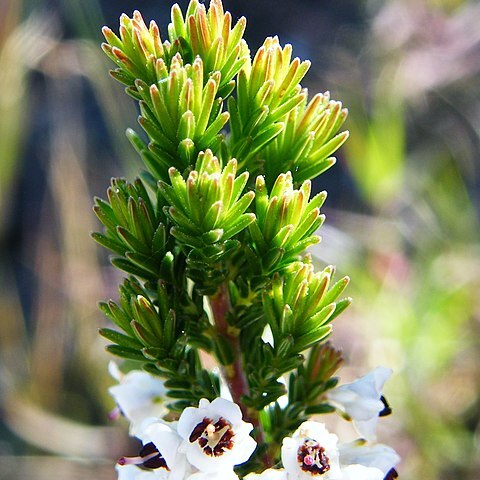Erect, stout and rigid shrub up to 60 cm (2 ft) or so. Branches numerous, white-pubescent. Leaves 3-nate, 5-6 mm long, upright to spreading, imbricate, linear to narrow-lanceolate, subtrigonous, sulcate, glabrous or the youngest minutely puberulous, ciliate or naked. Flowers 3-nate, terminal, subcalycine to calycine; peduncles 3-5 mm long, white-tomentose more or less with plumose hairs intermixed; bracts remote to subapproximate, lax or, more rarely, imbricating the corolla, ovate to oblong, scarious, coloured. Sepals 2-3 mm long, ovate to orbicular, more or less imbricate, keel-tipped, scarious or cartilaginous, glabrous, ciliate or naked. Corolla 3-4 mm long, campanulate, dry, glabrous, white; lobes equal to or a little shorter than the tube, spreading to recurved but becoming erect, oblong or ovate. Filaments broad, slightly tapering upwards; anthers included but manifest, 1.3-2.0 mm long, terminal or subterminal, oblong or semi-lanceolate, acute or obtuse, bipartite, scabridulous, appendiculate; pore 2/3 the length of the cell; crests free, coarsely toothed or incised or subaristate with short, free, subulate, ciliolate or hairy awns. Ovary widely turbinate, glabrous or hispidulous at the apex, pallid; style shortly exserted, stout; stigma simple or clavate.
Stout shrub, up to 0.6-2.0 m high. Leaves 3-nate, imbricate, 5-6 mm long, narrowly lanceolate, sulcate, glabrous. Flowers 3-nate, terminal, calycine. Calyx sepals 2-3 mm long, ovate to orbicular, ± imbricate, keel-tipped, scarious or cartilaginous, glabrous. Corolla 3-4 mm long, campanulate, dry, glabrous, white, pink or purple; lobes ± equal to tube, spreading to recurved, oblong or ovate. Filaments broad, tapering upward; anthers manifest, 1.3-2.0 mm long, oblong or semi-lanceolate, acute, bipartite, scabridulous, muticous or appendiculate; pore 2/3 length of theca; crest free, coarsely toothed or subaristate with short, free, subulate, ciliolate appendages. Ovary widely turbinate, glabrous or hispidulous at apex, pallid; style shortly exserted, stout; stigma simple or clavate. Flowering time Aug.-Feb.
Erect, rigid shrublet to 1(-2) m. Flowers small, calycine, bell-shaped with recurved lobes, white, pink or purple.

